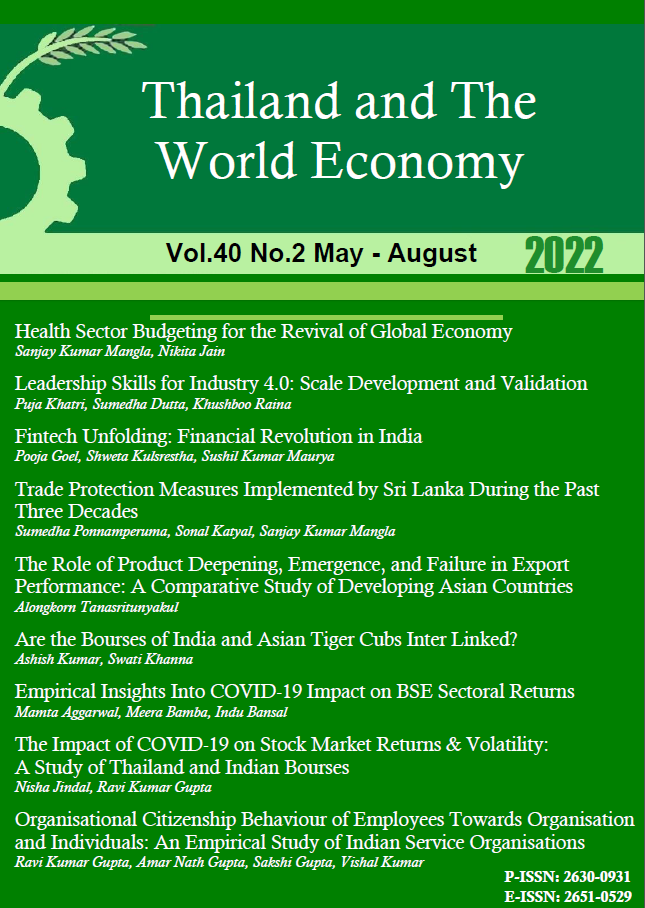The Role of Product Deepening, Emergence, and Failure in Export Performance: A Comparative Study of Developing Asian Countries
Keywords:
Trade margins, International trade, Export performanceAbstract
This study explores the contribution of the deepening of existing products (intensive margin), the emergence of new products (extensive margin), and the demise of existing products (failure margin) to the export expansion of developing Asian countries in 1990-2017. Using data based on the Standard International Trade Classification (SITC) revision 3 at the 5-digit level, we find that product deepening plays a crucial role in export success for total merchandise and its subcategories. There is less window opportunity for the emergence of new products when a country already has a high number of exported products. The emergence of new products and product failure margins are important for latecomer exporting countries in the region. GDP per capita, world demand, and FDI inflow have a positive impact on the deepening of existing products. Product emergence is significantly aided by trade barrier reductions.
References
Amiti, M., & Freund, C. (2008). The anatomy of China's export growth. In R. C. Feenstra & S. J. Wei (Eds.), China's Growing Role in World Trade (pp. 35-56). Chicago: University of Chicago Press.
Amurgo-Pacheco, A., & Pierola, M. D. (2008). Patterns of export diversification in developing countries: Intensive and extensive margins. (Policy Research Working Paper Series No. 4473). Washington, DC: The World Bank.
Athukorala, P. (2014). Global production sharing & trade patterns in East Asia. In I. Kaur, & N. Shin (Eds.), Oxford Handbook of Pacific Rim Economies (pp. 334-360). New York: Oxford University Press.
Athukorala, P. (2019). Joining global production networks: Experience and prospects of India. Asian Economic Policy Review, 14(1), 123-143.
Bernard, A., & Jensen, J. (1999). Exceptional exporter performance: Cause, effect or both?. Journal of International Economics, 47(1), 1-25.
Bernard, A. B., Jensen, J. B., Redding, S. J., & Schott, P. K. (2009). The margins of US trade. American Economic Review, 99(2), 487-93.
Besedes, T., & Prusa, T. J. (2006). Ins, outs, and the duration of trade. Canadian Journal of Economics/Revue Canadienne D'économique, 39(1), 266-295.
Besedes, T., & Prusa, T. J. (2011). The role of extensive and intensive margins and export growth. Journal of Development Economics, 96(2), 371-379.
Bigsten, A., & Gebeeyesus, M. (2009). Firm productivity and exports: Evidence from Ethiopian manufacturing. Journal of Development Studies, 45(10), 1594-1614.
Bjorvatn, K., & Coniglio, N. D. (2012). Big push or big failure? On the effectiveness of industrialization policies for economic development. Journal of the Japanese and International Economies, 26(1), 129-141.
Brenton, P., & Newfarmer, R. (2009). Watching more than the Discovery channel to diversify exports. In R. Newfarmer, W. Shaw & P. Walkenhorst (Eds.), Breaking into new markets: Emerging lessons for export diversification (pp. 111-124). Washingtons DC: The World Bank.
Dutt, P., Mihov, I., & Van Zandt, T. (2013). The effect of WTO on the extensive and the intensive margins of trade. Journal of International Economics, 91(2), 204-219.
Easterly, W., Reshef, A., & Schwenkenberg, J. (2009). The power of exports. (Policy Research Working Paper No. 5081). Washington DC: The World Bank.
Evenett, S. J., & Venables, A. J. (2002). Export growth in developing countries:
Market entry and bilateral trade flows, University of Bern working paper, mimeo.
Feenstra, R. C. (1994). New product varieties and the measurement of international prices. The American Economic Review, 84(1), 157-177.
Felbermayr, G. J., & Kohler, W. (2006). Exploring the intensive and extensive margins of world trade. Review of World Economics, 142(4), 642-674.
Gao, Y., Whalley, J., & Ren, Y. (2014). Decomposing China's export growth into extensive margin, export quality and quantity effects. China Economic Review, 29, 19-26.
Gopinath, G., Boz, E., Casas, C., Díez, F. J., Gourinchas, P.O., & Plagborg-Møller, M. (2020). Dominant currency paradigm. American Economic Review, 110(3), 677-719.
Gopinath, G., Itskhoki, O., & Rigobon, R. (2010). Currency choice and exchange rate pass-through. American Economic Review, 100(1), 304-36.
Hummels, D., & Klenow, P. J. (2005). The variety and quality of a nation's exports. American Economic Review, 95(3), 704-723.
Kehoe, T. J., & Ruhl, K. J. (2013). How important is the new goods margin in international trade?. Journal of Political Economy, 121(2), 358-392.
Perkins, D. H. (2013). East Asian development: Foundations and strategies. Massachusetts: Harvard University Press.
Rodrik, D. (1995). Getting interventions right: How South Korea and Taiwan grew rich. Economic Policy, 10(20), 53-107.
Veeramani, C., Aerath, L., & Gupta, P. (2018). Intensive and extensive margins of exports: What can India learn from China?. The World Economy, 41(5), 1196-1222.
Downloads
Published
How to Cite
Issue
Section
License

This work is licensed under a Creative Commons Attribution-NonCommercial-NoDerivatives 4.0 International License.










